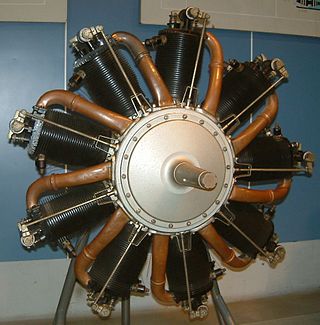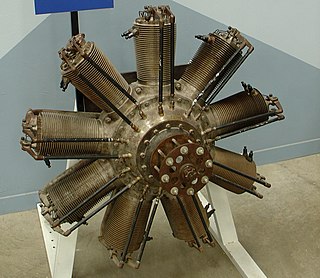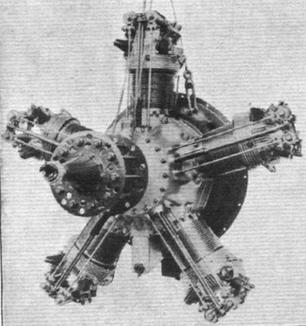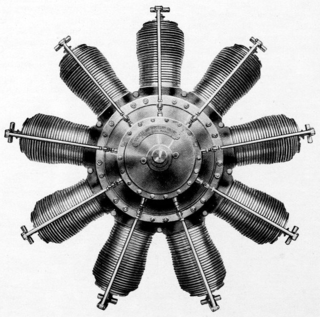
The rotary engine is an early type of internal combustion engine, usually designed with an odd number of cylinders per row in a radial configuration. The engine's crankshaft remained stationary in operation, while the entire crankcase and its attached cylinders rotated around it as a unit. Its main application was in aviation, although it also saw use in a few early motorcycles and automobiles.

The Monosoupape, was a rotary engine design first introduced in 1913 by Gnome Engine Company. It used a clever arrangement of internal transfer ports and a single pushrod-operated exhaust valve to replace the many moving parts found on more conventional rotary engines, and made the Monosoupape engines some of the most reliable of the era. British aircraft designer Thomas Sopwith described the Monosoupape as "one of the greatest single advances in aviation".
Motorenfabrik Oberursel A.G. was a German manufacturer of automobile, locomotive and aircraft engines situated in Oberursel (Taunus), near Frankfurt (Main), Germany. During World War I it supplied a major 100 hp-class rotary engine that was used in a number of early-war fighter aircraft designs. In 1921 the company merged with Deutz AG, and then again in 1930 with Humboldt-Deutz Motoren, and finally in 1938 with Klöcknerwerke AG. From this point on they were known as the Klöckner-Humboldt-Deutz Oberursel factory, known primarily for their locomotive engines. Today they are part of Rolls-Royce Deutschland, and produce one family of their jet engines.

Clerget was the name given to a series of early rotary aircraft engine types of the World War I era that were designed by Pierre Clerget. Manufactured in France by Clerget-Blin and in Great Britain by Gwynnes Limited they were used on such aircraft as the Sopwith Camel and Vickers Gunbus.

Gnome et Rhône was a major French aircraft engine manufacturer. Between 1914 and 1918 they produced 25,000 of their 9-cylinder Delta and Le Rhône 110 hp (81 kW) rotary designs, while another 75,000 were produced by various licensees. These engines powered the majority of aircraft in the first half of the war, both Allied designs as well as German examples produced by Motorenfabrik Oberursel.

Le Rhône was the name given to a series of rotary aircraft engines built between 1910 and 1920. Le Rhône series engines were originally sold by the Société des Moteurs Le Rhône and, following a 1914 corporate buyout, by its successor company, Gnome et Rhône. During World War I, more than 22,000 nine cylinder Le Rhône engines were built, with the type far outselling Gnome et Rhône's other main wartime engine series, the Gnome Monosoupape.

The Thulin LA was a Swedish two-seat, single-engine biplane designed by Enoch Thulin in 1917 and made by his company AB Thulinverken in Landskrona. It was based on the earlier Thulin L and E aircraft, with a new engine, fuselage and empennage. The L and E types were in turn based on the German Albatros B.II aircraft, like the NAB Albatros. The Thulin LA was used in Sweden, the Netherlands (10) and Finland (1). This type also made the first passenger transport flights between Sweden and Denmark in 1919. Altogether there were 15 Thulin LAs built.
The Benz Bz.III was a six-cylinder, water-cooled, inline engine developed in Germany for use in aircraft in 1914. Developing 112 kW (150 hp) at 1,400 rpm from 14.3 L, it powered many German military aircraft during World War I. It was replaced in production by the unrelated Benz Bz.IIIa. and eventually the V-8 Benz Bz.IIIb. The Benz Bz.III was built under licence in Sweden by AB Thulinverken, known as the Thulin E.

The Le Rhône 9J is a nine-cylinder rotary aircraft engine produced in France by Gnome et Rhône. Also known as the Le Rhône 110 hp in a reference to its nominal power rating, the engine was fitted to a number of military aircraft types of the First World War. Le Rhône 9J engines were produced under license in Great Britain by W.H. Allen Son & Company of Bedford, and in Germany by Motorenfabrik Oberursel where it was sold as the Oberursel Ur.II.

The Le Rhône 9C is a nine-cylinder rotary aircraft engine produced in France by Société des Moteurs Le Rhône / Gnome et Rhône. Also known as the Le Rhône 80 hp in a reference to its nominal power rating, the engine was fitted to many military aircraft types during the First World War. Le Rhône 9C engines were also produced under license in Great Britain, the United States and Sweden.

The Bristol Titan was a British five-cylinder air-cooled radial engine, designed and built by the Bristol Aeroplane Company in the late 1920s. It had the same size cylinders as the earlier Bristol Mercury engine, 5.75 in × 6.5 in, and produced between 200–240 hp (150–180 kW). Later versions of the Bristol Titan also used a Farman-style reduction gear produced by Gnome-Rhône.

The Gnome-Rhône 7K Titan Major was a seven-cylinder 370 hp (270 kW) air-cooled radial engine, that started life as an enlarged Gnome-Rhône 5K with two extra cylinders.

The Thulin K was a Swedish naval fighter aircraft in the 1910s. It was operated by both the Swedish and Dutch armed forces.

The Gnome 7 Omega is a French seven-cylinder, air-cooled aero engine produced by Gnome et Rhône. It was shown at the Paris Aero Salon held in December 1908 and was first flown in 1909. It was the world's first aviation rotary engine produced in quantity. Its introduction revolutionized the aviation industry and it was used by many early aircraft. It produced 37 kW (50 hp) from its 8 L (490 cu in) engine capacity. A Gnome Omega engine powers the 1912 Blackburn Monoplane, owned and operated by the Shuttleworth Collection, the oldest known airworthy British-designed aeroplane worldwide. A two-row version of the same engine was also produced, known as the Gnome 14 Omega-Omega or Gnome 100 hp. The prototype Omega engine still exists, and is on display at the United States' National Air and Space Museum.

The Gnome 9 Delta was a French designed, nine-cylinder, air-cooled rotary aero engine that was produced under license in Britain. Powering several World War I era aircraft types it produced 100 hp (75 kW) from its capacity of 16 litres (980 cu in).

The Gnome 7 Lambda was a French designed, seven-cylinder, air-cooled rotary aero engine that was produced under license in Britain and Germany. Powering several World War I-era aircraft types it was claimed to produce 80 horsepower (60 kW) from its capacity of 12 litres although recorded figures are lower.
The Gnome 7 Gamma was a French designed, seven-cylinder, air-cooled rotary aero engine. Powering several pre-World War I era aircraft types it produced 70 horsepower (52 kW) from its capacity of 12 litres.

The Clerget 7Z was a seven-cylinder rotary aircraft engine of the World War I era designed by Pierre Clerget. First appearing in 1911 it was nominally rated at 80 horsepower (60 kW). 347 examples were jointly built in Britain by Gordon Watney & Co Ltd of Weybridge and Gwynnes Limited of Hammersmith.

The Gnome 7Σ Sigma is a French seven-cylinder, air-cooled rotary aero engine.













